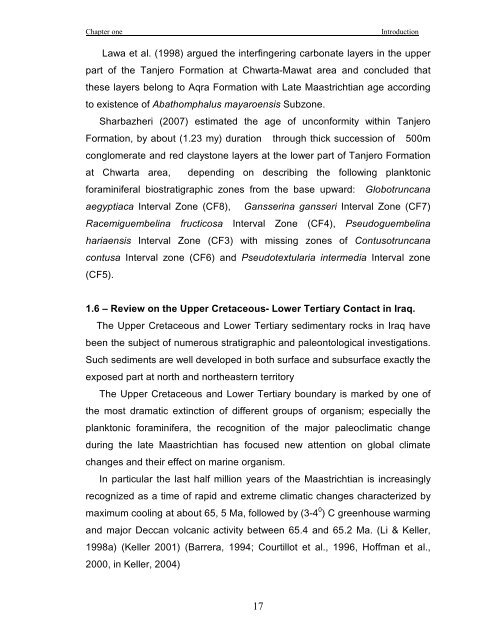biostratigraphy and paleoecology of cretaceous/tertiary boundary in ...
biostratigraphy and paleoecology of cretaceous/tertiary boundary in ...
biostratigraphy and paleoecology of cretaceous/tertiary boundary in ...
Create successful ePaper yourself
Turn your PDF publications into a flip-book with our unique Google optimized e-Paper software.
Chapter one<br />
Introduction<br />
Lawa et al. (1998) argued the <strong>in</strong>terf<strong>in</strong>ger<strong>in</strong>g carbonate layers <strong>in</strong> the upper<br />
part <strong>of</strong> the Tanjero Formation at Chwarta-Mawat area <strong>and</strong> concluded that<br />
these layers belong to Aqra Formation with Late Maastrichtian age accord<strong>in</strong>g<br />
to existence <strong>of</strong> Abathomphalus mayaroensis Subzone.<br />
Sharbazheri (2007) estimated the age <strong>of</strong> unconformity with<strong>in</strong> Tanjero<br />
Formation, by about (1.23 my) duration through thick succession <strong>of</strong> 500m<br />
conglomerate <strong>and</strong> red claystone layers at the lower part <strong>of</strong> Tanjero Formation<br />
at Chwarta area, depend<strong>in</strong>g on describ<strong>in</strong>g the follow<strong>in</strong>g planktonic<br />
foram<strong>in</strong>iferal biostratigraphic zones from the base upward: Globotruncana<br />
aegyptiaca Interval Zone (CF8), Gansser<strong>in</strong>a gansseri Interval Zone (CF7)<br />
Racemiguembel<strong>in</strong>a fructicosa Interval Zone (CF4), Pseudoguembel<strong>in</strong>a<br />
hariaensis Interval Zone (CF3) with miss<strong>in</strong>g zones <strong>of</strong> Contusotruncana<br />
contusa Interval zone (CF6) <strong>and</strong> Pseudotextularia <strong>in</strong>termedia Interval zone<br />
(CF5).<br />
1.6 – Review on the Upper Cretaceous- Lower Tertiary Contact <strong>in</strong> Iraq.<br />
The Upper Cretaceous <strong>and</strong> Lower Tertiary sedimentary rocks <strong>in</strong> Iraq have<br />
been the subject <strong>of</strong> numerous stratigraphic <strong>and</strong> paleontological <strong>in</strong>vestigations.<br />
Such sediments are well developed <strong>in</strong> both surface <strong>and</strong> subsurface exactly the<br />
exposed part at north <strong>and</strong> northeastern territory<br />
The Upper Cretaceous <strong>and</strong> Lower Tertiary <strong>boundary</strong> is marked by one <strong>of</strong><br />
the most dramatic ext<strong>in</strong>ction <strong>of</strong> different groups <strong>of</strong> organism; especially the<br />
planktonic foram<strong>in</strong>ifera, the recognition <strong>of</strong> the major paleoclimatic change<br />
dur<strong>in</strong>g the late Maastrichtian has focused new attention on global climate<br />
changes <strong>and</strong> their effect on mar<strong>in</strong>e organism.<br />
In particular the last half million years <strong>of</strong> the Maastrichtian is <strong>in</strong>creas<strong>in</strong>gly<br />
recognized as a time <strong>of</strong> rapid <strong>and</strong> extreme climatic changes characterized by<br />
maximum cool<strong>in</strong>g at about 65, 5 Ma, followed by (3-4 0 ) C greenhouse warm<strong>in</strong>g<br />
<strong>and</strong> major Deccan volcanic activity between 65.4 <strong>and</strong> 65.2 Ma. (Li & Keller,<br />
1998a) (Keller 2001) (Barrera, 1994; Courtillot et al., 1996, H<strong>of</strong>fman et al.,<br />
2000, <strong>in</strong> Keller, 2004)<br />
17

















